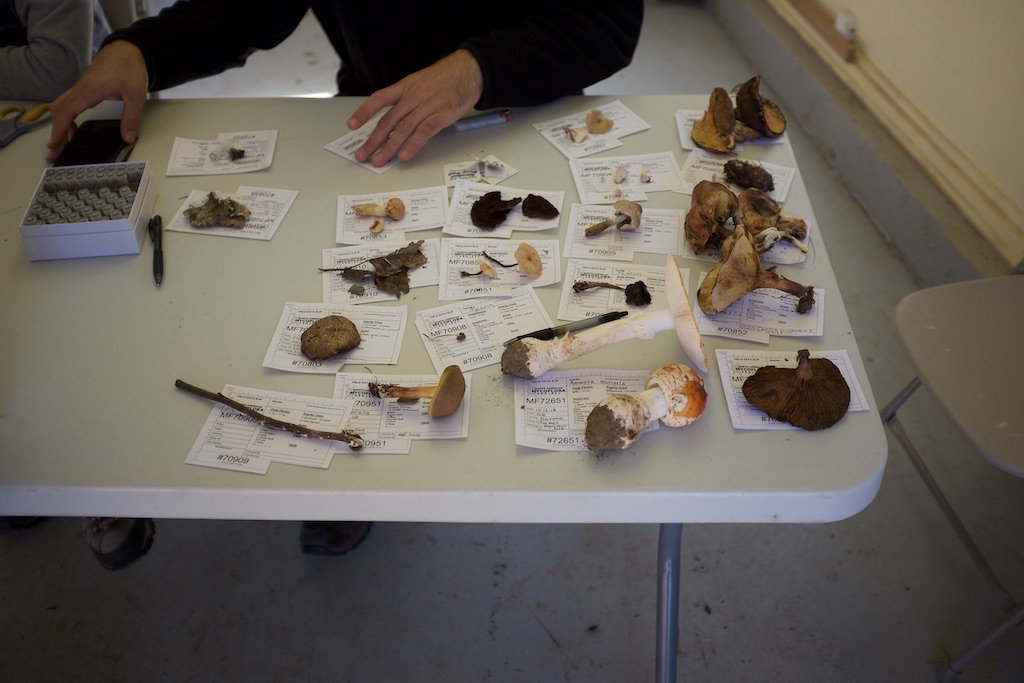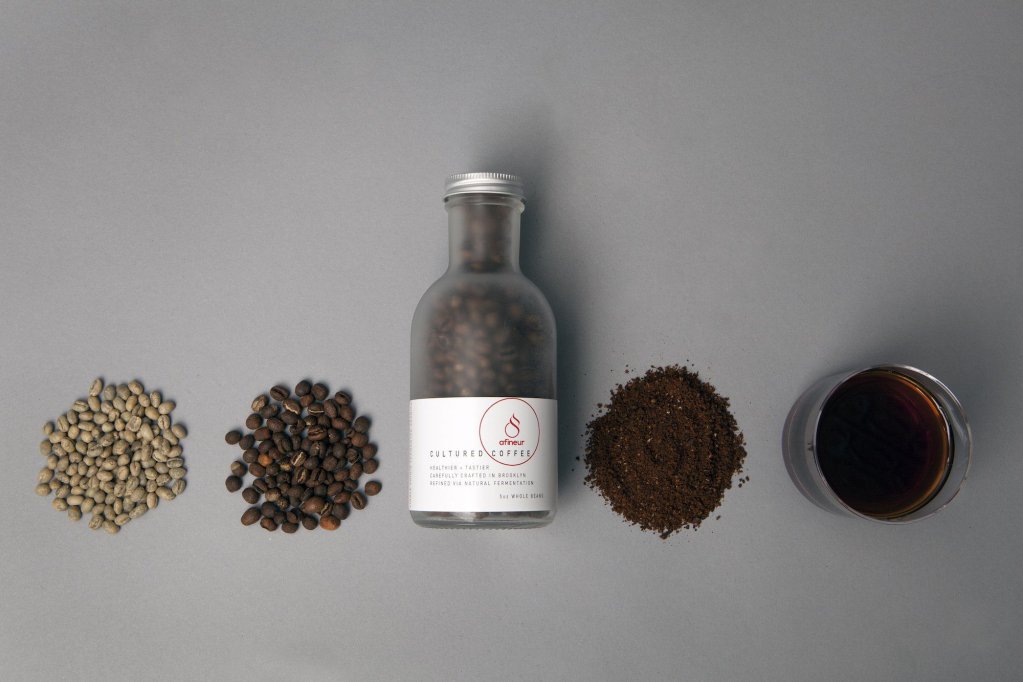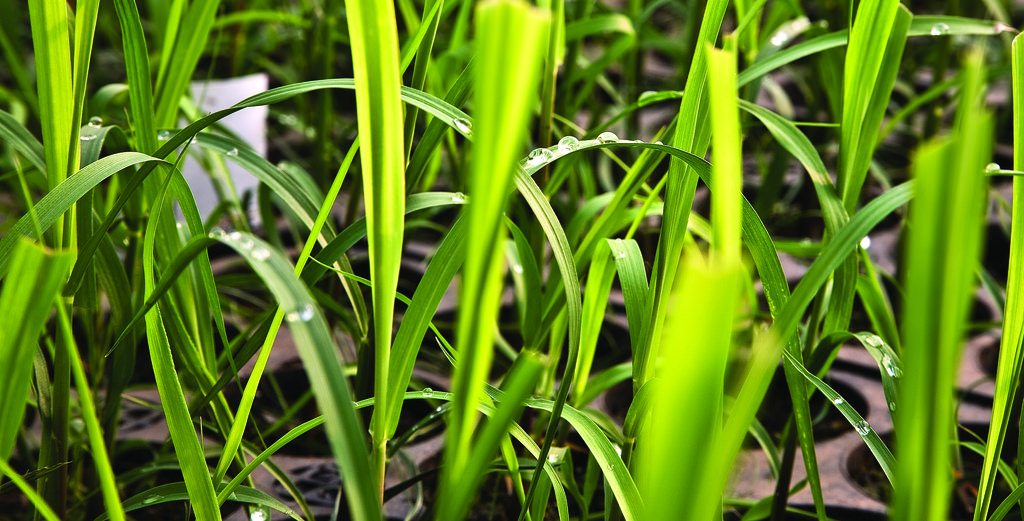
Doug Bierend
At the fifth biennial Radical Mycology Convergence (RMC) in September, some 600 mycophiles—folks fascinated by fungi and mushrooms—gathered on a small farm in the hilly hamlet of Mulino, Oregon. With Mount Hood looming beyond the treetops, naturalists of all stripes gathered to share knowledge, skills, art, shroom swag, and to let their fungus flags fly.
At first glance, the conference is about what you’d expect from a fungus festival in the Pacific Northwest. There were the baskets filled with colorful curios plucked from the forest, bearded old-timers scrutinizing mysterious truffles, the sound of Tuvan throat singing and occasional wafts of pungent smoke. (This was officially a drug-free event, although downwind cannabis use was permitted). Yours truly may have unwittingly consumed a small dose of psilocybin passed around as ‘honey’ during a lecture in the woods. “Everyone knows the honey is psilocybin,” one attendee later said, incorrectly.
But underlying an informal, playful air was a serious conviction in the vast, as-yet-untapped power of fungi to change the world. The modern mycological conversation is vast: Proponents highlight the critical role mycelia play in Earth’s ecosystems; their potential for mitigating pollution, waste and contamination; the vast world of culinary and medicinal mushrooms; the growing field of fungal fabrication; and the eerily intelligent behavior of distributed fungal networks—often referred to as “nature’s internet.” Underscoring these wide-ranging discussions was a common theme: that a deeper understanding of the interrelations among plant, animal, and fungal life is necessary to navigate a fraught future.
 Doug Bierend
Doug Bierend Peter McCoy holds the portable speaker on the far right at a ‘mycohack’, an event designed to circulate knowledge about cultivation techniques. McCoy is the unofficial, seemingly reluctant leader of the Radical Mycology movement—he coined the term
But as this oft-maligned and overlooked field begins to enjoy greater reach and awareness, there is some anxiety about steering it all in the right direction. Radical mycology aims to reconnect mushrooms, and a broader ecological perspective, to culture in a variety of ways—some new, some rediscovered. The conference may be a bellwether for how the future of mycological innovation will look, but only if the values it stands for–inclusivity, sustainability, open source transparency, and a general sense of belonging to the earth–are upheld.
A neglected megascience
Fungi are implicated in medicine, health, food security, industry and manufacturing, pollution and even climate change. For example, mycelium is key in the process of digestion that turns dead organic matter—fallen trees, plowed-under fruit, and so on—into nutrients that form soil, and is therefore involved in the question of how or whether the gigatons of carbon stored in that soil will make their way into the atmosphere. It’s one example of the high-stakes processes in which fungi are fundamental.
Yet much of the fungal world remains undocumented, and the potential applications and insights gleaned from its study do not match its level of priority as a research subject. Hence, mycology is described by some as a ‘neglected megascience.’
 Doug Bierend
Doug Bierend Jordan Weiss, a Portland-based educator and author, holds a truffle. He was approached by numerous people after his lecture to help identify various weird things they’d found in the woods.
“Unfortunately, the academic mycological world is shrinking in North America. People are aging out or dying at their positions and not being replaced at universities,” said Christian Schwarz, a naturalist and author. His talk at the RMC covered the effects of climate change on fungus, and urged a scaling-up of citizen science projects. “I don’t know why it is that we still have this massive blind spot for this third kingdom of hyperdiverse eukaryotes. But we can go to many universities and there will be a big building that says ‘botany’ at the top, and a big building that says ‘zoology,’ and you’d never find one that has ‘mycology’ at the top.”
Without much in the way of institutional interest, it’s fallen largely on the amateurs to drive mycological investigations in new directions. That makes for an unevenly distributed body of knowledge and experience that’s best shared through community networks.
Obviously, the internet has been helpful in this regard. It’s certainly been a factor in the expanding reach of Radical Mycology culture, first promulgated through DIY zines. Apps like iNaturalist are popular in this scene as a platform for citizen science projects. Though novel homebrew projects like training fungus to digest cigarette butts gets a lot of clicks on YouTube, the far less sexy work of documentation and identification remains key to the advancement of the field.
Russell spent much of the RMC at a folding table in a small garage, where some 40 varieties fungus were gradually stacked as part of a volunteer collection project. Tissue samples of each specimen were inserted into vials to be sent off to Purdue University in Indiana for sequencing, the beginning of an account of the area’s fungal diversity.
By chance, about half an hour away in Salem, NAMA held its annual foray on the same weekend as the RMC. Forays—group foraging trips into the woods—are at the core of the traditional mycology gatherings. There is comparatively little attention given to the diversity of interests represented at the RMC. Russell and his partner dashed between the two events throughout the weekend, describing the scene in Salem as “A little older. That’s why we wanted to spend time here, it’s a younger audience. There’s also more of a focus on applied mycology versus just pure mushroom taxonomy.”
Distance from academia and other staid institutions may actually be why the Radical Mycology movement offers a viable path forward for the field. In more free-wheeling settings like the RMC, it’s possible to raise questions that might shut down conversation in more conservative contexts. That may explain the large number of young people at the RMC, and why its organizers have been approached by other, more traditional mycological groups hoping to learn how to attract more of them.
 Doug Bierend
Doug Bierend As the memberships of traditional mycological groups grow older, organizers are looking for new ways to attract young mycophiles
“Even though what we do, what I do, is very unlike what they’re used to in mycology, there’s something about it, which they can’t put their finger on, that appeals to the youth,” said Peter McCoy, setting down a piñata shaped like a split-gill mushroom. Wearing a signature baseball cap and thick-glass spectacles, McCoy is the unofficial, seemingly reluctant leader of the Radical Mycology movement—he coined the term and literally wrote the book.
“That’s sort of an ongoing discussion, because they recognize that their membership is [aged] 45 and above, or 55 and above, predominantly, and they’re worried that their local knowledge, which they’ve garnered and passed on to each other for decades, might fade away if the next generation just doesn’t care.”
Growing interest means casting as wide a net as possible, and the RMC makes this its mission. “It covers everything from the more obscure philosophical conversations around mushrooms, and then gets into the really practical applications,” said Jason Scott, one of three organizers behind this year’s event. He stood beside a table laden with various tinctures for sale, a soggy pair of orange cordyceps peeking over his coffee cup.
For Scott, this was a rare opportunity to engage his expertise in permaculture, mushroom cultivation, and alchemy. “Mushroom people are typically pretty weird, and alchemy people are pretty open-minded. But that’s what they have in common—they’re fringe topics, and the culture is wide.”
Growing a myco culture
In the milky light of a packed side room, McCoy began his first talk of the weekend by asking who was new to mushroom cultivation. At least two-thirds of the audience raised their hands, many holding pens that would later be used to furiously scribble notes.
After all, not everybody is equipped for—or interested in—an intense inquiry into the molecular details of mycorrhiza, or the chemical processes involved in creating biochar. Some are just fascinated by fungi for their uses in the kitchen, the experience of finding them in the woods, or the kind of art they inspire. All of these are seen as ports to the same ultimate destination: a deeper consideration of and relationship to the natural processes of the world.
All of these interests are viewed by the RMC’s leadership as equally valid. As a result, the focus was split between the highly rigorous work of doing science and the subjective work of creating culture. There is an acknowledgement of the difference between the two, but they are also seen as inextricably linked.
“It’s empowering to be able to understand that all these things are happening around you, micro to macro,” said Matt Powers, an educator whose crowdfunded permaculture textbooks feature a significant mycological aspect. In promoting the book, he explained that solving the problems of pollution and collapsing ecosystems is “going to take partnering with the most powerful force on Earth: Nature. It’s going to actually take shaping our culture to partner with nature, and it’s going to have to be permanent. It’s going to have to be a permanent culture that partners with nature—that’s what permaculture is.”
 Doug Bierend
Doug Bierend Mushroom merchandise and mycological swag for a movement that is widespread yet still fringe
Despite having played key roles in human society for millennia, fungi are often seen as belonging to the realm of the esoteric. A room filled with plants is not going to raise an eyebrow; a room full of spawn bags sprouting with fruiting bodies certainly will. Some may wonder about the RMC attendee who called out to her children with, “Come along, spores!” Would someone say the same if she’d used the term “seedlings” or “pups” instead? Even farmers, whose work is literally tied up in mycelium, often see it as little more than the basis of the mushrooms they sell. Any deep sense of relationship to fungi has largely been lost in the western world, despite their prominent role throughout human history, and in many cultures to this day.
In the mycological sphere, the tendency to downplay or overlook the role and potential use of mushrooms is credited to “mycophobia,” or fear of fungi. The term “fungiphobia” was coined in the late 19th century by William Delisle Hay, who wrote that fungi “are lumped together in one sweeping condemnation. They are looked upon as vegetable vermin only made to be destroyed. … the individual who desires to engage in the study of them must boldly face a good deal of scorn.”
Modern mycophiles insist that this phobia lives on today.
“People are taught to fear mushrooms, they’re taught not to touch them, not to go near them, they’ll make you sick,” said Laura Kennedy, another of the organizers for this year’s RMC. “We’re actually much more related to them than we are to plants, and it’s so overlooked and so feared that I think it’s hard for people to consider them.”
These gains seem to be driven largely by increasing interest in the medicinal applications of mushrooms, including the psychoactive variety currently being studied under a widely publicized research program at Johns Hopkins University in Baltimore, Maryland.
But as mushrooms become more popular, concerns are also raised about the culture that will emerge around them. Increased study and commercial use of fungi may lead to pharmacitization, as sacred medicines are abstracted into pills, and natural processes industrialized to scale without adequate considerations of the impact on ecologies. Mycophiles’ enthusiasm over a growing profile for fungi is tempered by concerns that it may come at a cost.
Foraging for example is growing more and more popular. While this is increasing the profile of mushrooms, it may lead growth in a direction that’s not ideal for the ecosystems in which they’re found.
“It’s like this trendy, hipster thing, which makes me sad in some ways because again, they’re not really considering the ethics. They just want to go and hunt mushrooms because it’s fun, and they don’t really understand the ecological impacts of that,” said Kennedy. “People are working in tech industries and things like that, and need to connect to nature because we’re so disconnected in our everyday lives.”
 Doug Bierend
Doug Bierend Mycophiles are stuck wondering how to scale up their movement without sacrificing its open-source ethos
One of the benefits of setting a wide gate for inclusion is creating a culture around mushrooms that’s robust and representative of many perspectives. But at this still-early stage, it means working to ensure that values of non-hierarchical inclusion are upheld. Inviting everyone to get involved necessarily means some will feel less included. In the event literature, more space was given to the zero-tolerance policy towards oppressive behavior than to drug and alcohol consumption. A conflict mediation team was on hand to address any issues of discrimination.
A panel discussion titled “Justice for Psilocibina” centered on the deep cultural roots of psilocybin as a traditional medicine in Oaxaca, Mexico and other parts of South and Central America, how its role had shifted from sacred, secret medicine into a tourist attraction, a schedule 1 drug, and a target of resource extraction for companies like Compass Pathways, a company whose investors include the infamous entrepreneur and venture capitalist, Peter Thiel.
In a breakout discussion after the talk, about a dozen people—mostly white— discussed in small groups their ideas about how to approach the project of decriminalization from different angles. In one group designated to discuss the media angle, conversations dwelled on memes and other low-hanging fruit of the internet age. After the groups reconvened, a young woman named Natalie, visiting the RMC with friends from Mexico, interjected.
“You guys need to think of your privilege. That medicine was sacred for a reason, for them, because there’s so much trauma that we have from colonization, from capitalism, all these things. It’s very sacred medicine, and it was kept secret for a reason.”
Fungi offer many reasons to get interested and excited. They represent a massive potential for ecological applications, for food, for making money. They also represent nature itself, and traditions that aren’t necessarily top of mind for people who haven’t encountered them.
Carrying mycology forward as part of an ecologically and socially sustainable future will require the consideration of many diverse interests and perspectives. And the myco-culture, like fungus itself, to be diverse in order to be resilient.
“If you look at the mycological world, it’s a lot of older, white men that have been in charge of things for a very long time, over naming things, over all the complexities, and there’s not really been a graceful transition to the next generations, or to a more diverse audience,” said a woman named Heather, during her shift selling mushroom-themed shirts. “There’s something here that feels like a soup, out of which will emerge something tangible.”










